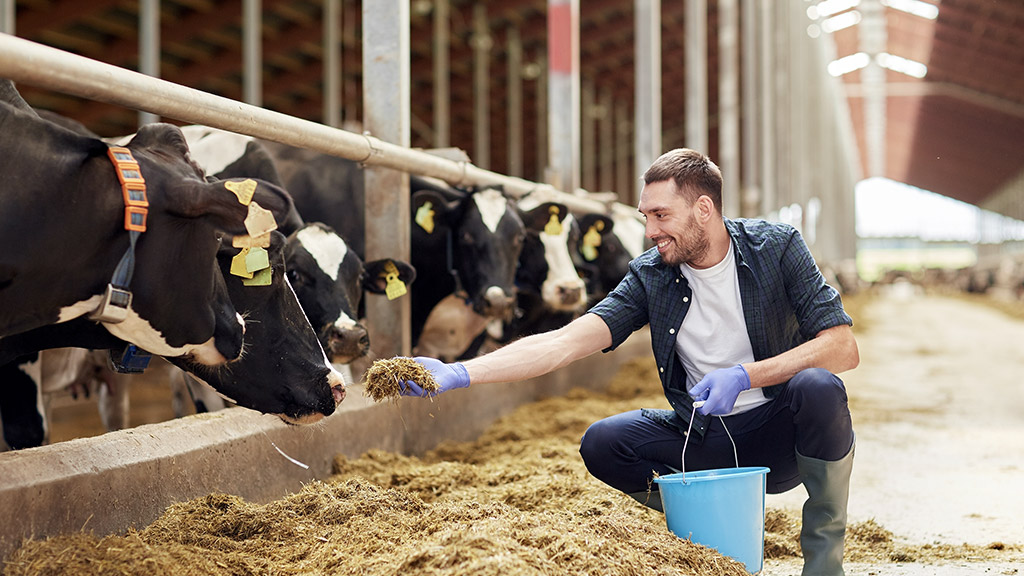Proper feeding and watering practices are essential components of animal care, ensuring the animals remain healthy, hydrated, and well-nourished. In settings such as pet stores, animal hospitals, or reptile parks, following these steps ensures that each species gets the proper diet and water requirements to support their well-being.
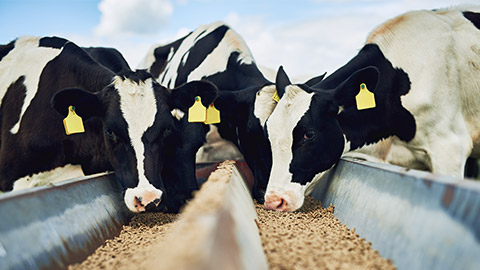
Feeding Animals
- Species-Specific Diets: Each species has unique dietary needs. Carnivores, herbivores, and omnivores require different types of food, and within these groups, there are individual preferences and restrictions.
- Dogs and Cats: They typically receive commercial kibble or wet food formulated for their life stage and health condition. Treats are provided in moderation.
- Birds: Diets vary by species but can include seeds, fruits, vegetables, and insects for omnivores or pellets for pet birds.
- Reptiles: Depending on the species, reptiles may require live prey (insects or small rodents), frozen-thawed prey, or plant-based diets (greens, fruits).
- Small Mammals: Rabbits, guinea pigs, and hamsters often eat hay, pellets, and fresh produce.
- Meal Timing: Animals are usually fed based on their natural feeding habits and metabolic needs.
- Dogs and cats are fed one to three times daily, while reptiles and birds may have different intervals (daily, weekly, or longer gaps for larger reptiles).
- Small mammals often have continuous access to hay, while pellets and vegetables are given in portions throughout the day.
- Portion Control: Each animal’s food is measured to avoid overfeeding or underfeeding, which can lead to health issues like obesity, malnutrition, or digestive problems.
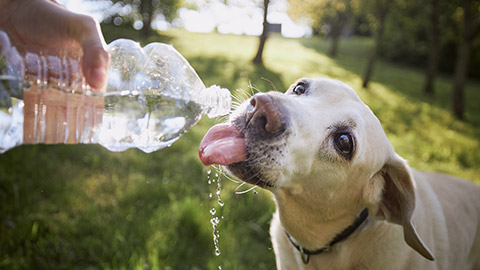
Watering Animals
- Fresh Water Availability: All animals require constant access to clean, fresh water. In most settings, water is refreshed at least once daily, and water bowls or bottles are cleaned regularly to prevent contamination.
- Watering Methods: Different species may drink from bowls, water bottles (for small mammals), or drip systems (common for reptiles).
- Hydration Monitoring: It's important to monitor the water intake of animals, especially those that may not show signs of dehydration until it becomes severe (e.g., reptiles). Ensuring that birds, mammals, and reptiles drink adequately helps prevent health problems related to dehydration.
Important Considerations:
- Food Storage: Proper storage prevents spoilage and contamination. Dry foods are kept in sealed containers, and wet or fresh foods are refrigerated or frozen as needed.
- Special Dietary Needs: Some animals may have special diets due to health issues or age. Tailoring the food to individual animals ensures their specific needs are met.
- Prohibited Foods: Certain foods are dangerous for different species (e.g., chocolate for dogs, avocado for birds). Caregivers must be aware of these to avoid accidental poisoning.
Meet Robert (and Misty)...
Robert works at Mountain View Trail Rides, a business that takes members of the community out on horse trail rides in the nearby bushland. The business owns 35 horses. However, they rotate these in and out of active service throughout the year. Robert and his colleagues typically look after about 15 horses at any one time. The daily duties involve feeding and watering each horse. Depending on the horse's size, age, and activity requirements, the feed portion may differ in terms of ingredients and supplements. The property owned by Moutain View Trail Rides also has a variety of other farm animals that form a petting zoo feature. Animals at this attraction include donkeys, sheep, chickens, pigs, and guinea pigs. Roberts assists with feeding and watering these animals as well as the horses.
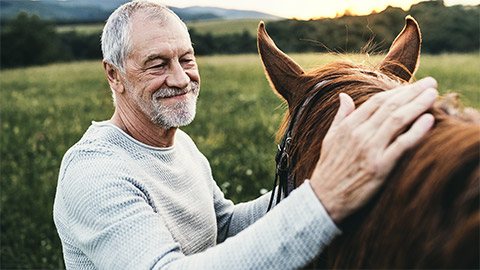
What do you feed the horses?
We combine a grain mix that includes oats and barley with a bit of molasses and soybean meal for protein. This provides them with the necessary energy they need for the day. They are also able to eat grass whilst on their trail rides. Some of the horses get additional supplements because they are older or have a variety of medical conditions. We also provide them with salt, which is important for a horse's digestion. In the evening, they get a portion of hay to munch on.
How often do the horses get fed?
Horses need to eat quite regularly. They get the majority of their feed in the morning because they are about to undertake a full day of exercise. They regularly eat bits of grass whilst on the trail rides. Some of them are really greedy and will overpower the riders to reach for a tasty clump of grass. After they get back from the ride and are settled in their yards or in our stable area, they get their hay portion.
How do you store the food?
In large plastic tubs. It gets delivered in canvas bags, but once these are opened, the food has to be stored more securely; otherwise, rats and mice will get to it. We also have to be careful not to allow fruit bat droppings to get into the feeding tubs as this can cause Hendra Virus, a very serious disease that horses and humans can get from contaminated food.
Is there anything that a horse is not allowed to eat?
Tomatoes are one thing that comes to mind. They cause constipation in horses. Garlic and onions are also not great for horse digestion. Horses are herbivores, so they don't eat meat or dairy products. We must watch the clients because they sometimes smuggle in all kinds of 'treats' for the horses, such as chocolate and sugar cubes, which are a big 'no-no'. We do let the riders feed the horses half an apple as a treat, though.
What about the other animals on your property? What do they eat?
The donkey eats a similar mix to the horses, and the sheep mainly eat grass in their paddock with a bit of extra hay provided for variety. The chickens and guinea pigs eat commercial feed pellets specific to their species, and the pigs, well, they eat almost anything ... they're very good garbage disposal units.
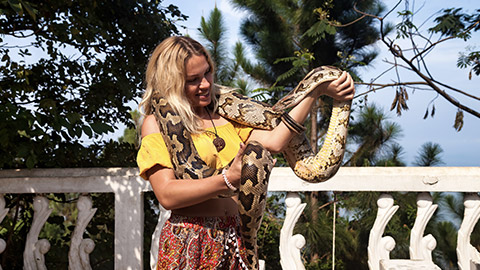
Meet Hannah, an animal handler at a Mid North Coast Reptile Park. Hannah is responsible for taking care of various species of snakes. As part of your daily tasks, you can also do shows, demonstrations, and animal talks at the park. Hannah assists with the health and well-being of the snakes by managing their feeding schedule and dietary needs, as well as considering other animals at the facility.
What do you feed the snakes?
Snakes are carnivorous, and their diet in captivity typically consists of rodents like mice, rats, and occasionally chicks or rabbits for larger species. In some cases, the diet may be supplemented with pre-killed or frozen prey, ensuring that it closely mimics what they would eat in the wild. It's important to provide appropriately sized prey to each snake based on its size and species to avoid choking or digestive issues.
How often do the snakes get fed?
The feeding frequency varies by species, age, and snake size. Younger snakes, for example, may need to eat once a week or more frequently, while adult snakes can go 1-2 weeks between meals. Larger snakes, such as pythons, might be fed only once every two to four weeks, depending on the size of the prey and the snake's activity level. Monitoring each snake’s condition and weight helps determine the ideal feeding schedule.
How do you store the food?
Food for the snakes is typically stored in a freezer to keep it fresh. Pre-killed or frozen prey, such as mice, rats, or chicks, is safely frozen to prevent spoilage and reduce disease risk. When it’s time to feed the snakes, the prey is thawed to room temperature before being offered to the animals. Labelling the stored prey with dates helps ensure that the food is used within a safe period.
Is there anything the snakes are not allowed to eat?
Yes, there are several restrictions when feeding snakes. Snakes should not be fed live prey as it can harm the snake, and it is not allowed in many facilities due to ethical considerations. Additionally, certain foods, like raw meats intended for human consumption, are inappropriate, as they don’t contain the necessary nutrients and could introduce harmful bacteria or parasites. Non-prey food items, such as plants or processed food, are unsuitable for snakes and could cause digestive issues or malnutrition.
What about the other animals at the facility? What do they eat?
Their diets will vary if the reptile park also cares for other reptiles, such as lizards or turtles.
- Lizards: Carnivorous lizards might eat insects, small rodents, or other reptiles, while herbivorous lizards, like iguanas, consume leafy greens, fruits, and vegetables.
- Turtles: Depending on the species, turtles can be omnivores, herbivores, or carnivores. Herbivorous turtles will eat vegetables, fruits, and leafy greens, while carnivorous turtles may consume fish, insects, and invertebrates.
- Crocodiles or alligators (if applicable): These reptiles are fed larger prey like fish, chicken, or small mammals, and their feeding schedule might be less frequent, similar to that of larger snakes.
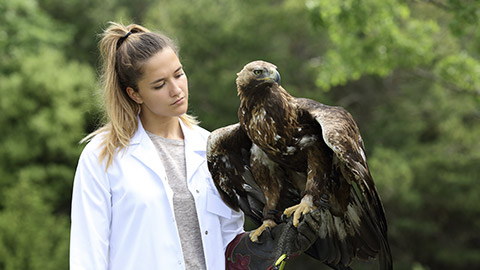
Meet Joelene, a dedicated animal care specialist who works at an animal hospital, focusing primarily on the care and rehabilitation of birds. With her extensive knowledge of avian species, Joelene ensures that the birds in her care receive the proper nutrition and medical attention they need. Her duties also include feeding, monitoring, and creating individualised care plans for each bird, ensuring their health and recovery.
What do you feed the birds?
The diet of the birds varies depending on the species. Birds may be fed various foods, including seeds, pellets, fresh fruits, vegetables, and insects. For carnivorous birds like raptors, Joel provides a diet of small mammals, like mice or rats, or occasionally fish. The hospital carefully selects species-appropriate foods, ensuring the birds get a balanced diet for their nutritional needs.
How often do the birds get fed?
Feeding frequency depends on the bird's species, age, and health condition. Smaller birds, like parrots or finches, typically need to be fed multiple times a day, while larger birds of prey, like hawks or eagles, may only require feeding once daily or even less frequently. Joel works closely with the veterinarians to ensure that each bird’s feeding schedule is tailored to their specific needs.
How do you store the food?
The food is stored based on its type. Seeds and pellets are kept in airtight containers to maintain freshness and prevent spoilage. Fresh produce is stored in the refrigerator, while frozen prey like mice or fish is kept in the freezer. Joel ensures that food storage is carefully managed to maintain hygiene and quality, preventing contamination and ensuring that the birds receive safe, nutritious meals.
Is there anything the birds are not allowed to eat?
Yes, certain foods are harmful to birds. Joel ensures that birds do not consume foods like chocolate, avocado, alcohol, caffeine, or foods high in salt and fat, as these can be toxic to them. Additionally, birds should not be fed processed human foods, as these can lead to nutritional deficiencies and health issues.
What about the other animals at the facility? What do they eat?
Aside from birds, the hospital may also care for mammals or reptiles.
- Mammals: Depending on the species, mammals may be fed specially formulated kibble, fresh produce, or, in the case of carnivores, raw meat.
- Reptiles: The diet for reptiles varies widely. Herbivorous reptiles may be fed leafy greens and vegetables, while carnivorous reptiles are given prey such as insects, rodents, or fish.

Meet James, an experienced employee at a pet store whose primary focus is the care and well-being of dogs and cats. James is responsible for feeding, cleaning, and providing general animal care while helping customers choose the right products and pets. With a passion for animal welfare, James ensures that all the pets in his care are healthy, happy, and well-fed.
What do you feed the dogs and cats?
James feeds the dogs and cats various high-quality commercial foods, including dry kibble and wet canned food, tailored to their age, breed, and health needs. For dogs, he might offer treats like biscuits or chews, while cats may receive treats such as soft or crunchy snacks designed for felines. Both species are occasionally given special diets if required for health issues, like grain-free food or foods for sensitive stomachs.
How often do the dogs and cats get fed?
Typically, dogs are fed once or twice daily, depending on their size, breed, and dietary requirements. Puppies may need more frequent meals to support their growth. Cats, on the other hand, are generally fed two to three small meals a day. Kittens might require even more frequent feeding. James adjusts the feeding schedule based on the animal's needs and age to ensure proper nutrition.
How do you store the food?
The pet food is stored in a cool, dry place, often in sealed containers, to maintain freshness and prevent pests. Wet canned food is kept unopened at room temperature but is refrigerated once opened to keep it fresh for the next feeding. James ensures that the food is rotated properly to avoid spoilage, and he follows storage guidelines for both dry and wet food to maintain its quality.
Is there anything the dogs and cats are not allowed to eat?
Yes, James ensures that dogs and cats do not eat harmful foods such as chocolate, grapes, raisins, onions, garlic, alcohol, or foods high in fat and salt. Raw dough, certain artificial sweeteners (like xylitol), and bones (especially cooked bones) are also restricted due to their potential risks. Human food, in general, is discouraged to avoid digestive issues and ensure that the pets get a balanced, species-appropriate diet.
What about the other animals at the facility? What do they eat?
The pet store may also house other animals, such as small mammals, birds, or reptiles.
- Small mammals (rabbits, guinea pigs, etc.): These animals are typically fed a diet of hay, pellets, and fresh vegetables.
- Birds: Depending on the species, birds may eat seeds, pellets, fruits, and vegetables.
- Reptiles: Reptiles like lizards or snakes may be fed insects, small rodents, or specially formulated reptile food.
